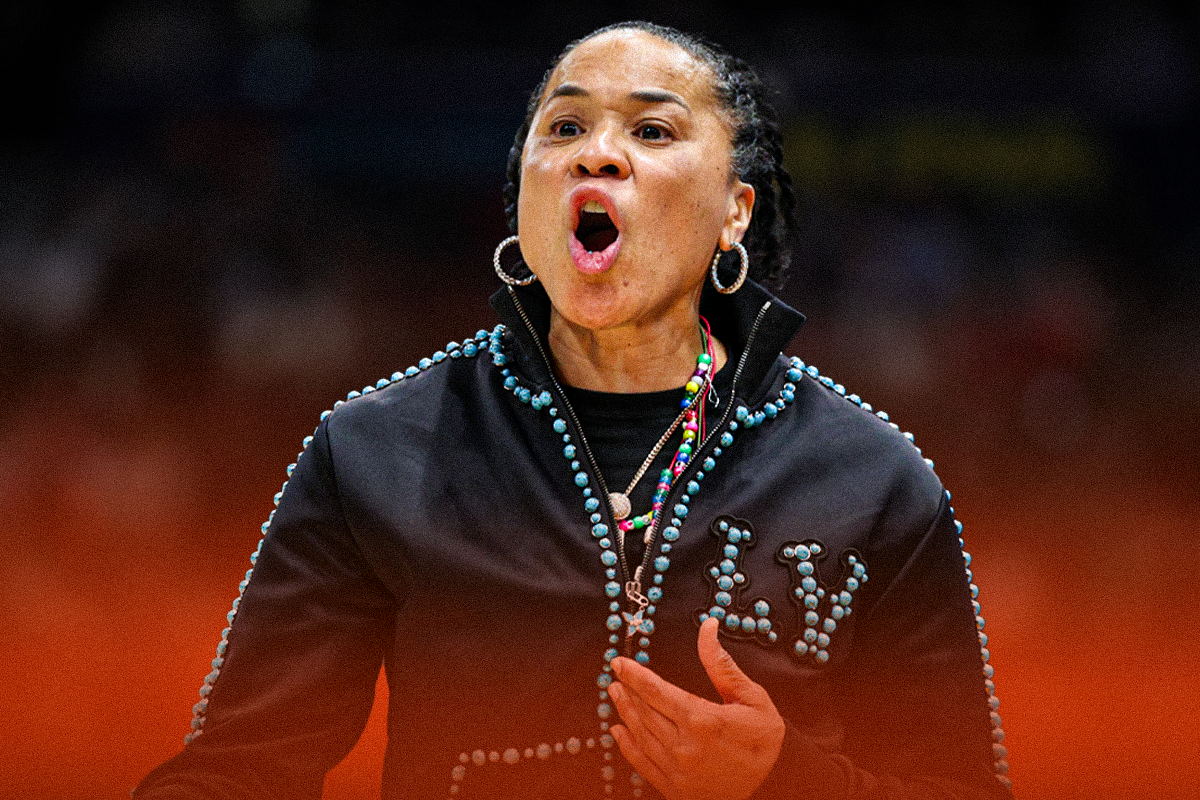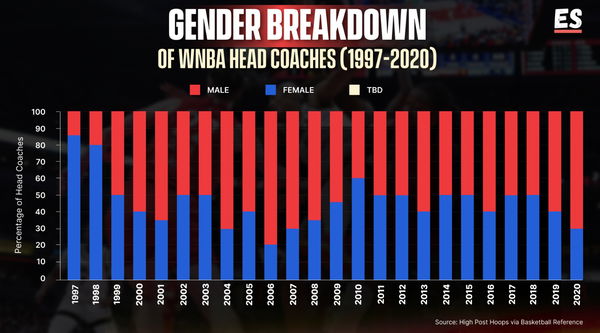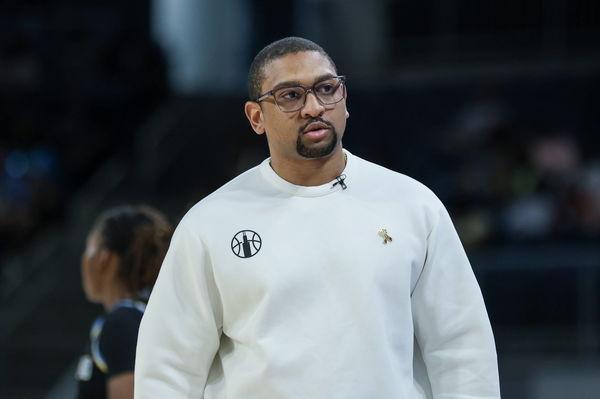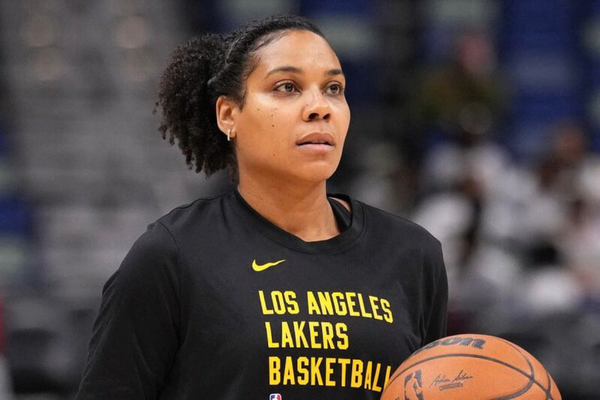
Imago
Credits: Imagn

Imago
Credits: Imagn
It’s been quite an offseason for Dawn Staley, and you know why. Fresh off another dominant run with South Carolina, the unthinkable happened: her name popped up in NBA circles! When the Knicks fired Tom Thibodeau in June, Staley became a real candidate to replace him.
Watch What’s Trending Now!
Staley reportedly met with the NY side’s front office, which had the whole community excited. Could one of college basketball’s greatest female coaches leap to the pros? In the end, they went with Mike Brown, but for a brief moment, fans imagined her pacing the sidelines under the bright lights of Madison Square Garden.
When the Gamecocks’ head coach sat down for her interview with the Knicks, it wasn’t your typical coaching interview. It carried the weight of breaking barriers for women in basketball. She appreciated that team president Leon Rose and executive VP William “Worldwide Wes” Wesley recognized the unique challenges that come with hiring a woman for one of the NBA’s most high-profile jobs.
ADVERTISEMENT
Dawn Staley knew that any woman stepping into that role would face scrutiny far beyond the norm…
“It’s not just hiring the first female coach. Because one, if I’m the Knicks coach and you have a five-game losing streak, it’s not going to be about the losing streak. It’s going to be about being a female coach. So you as an organization and a franchise, you have to be prepared about that and strong enough to endure those types of instances when you’re a female coach,” Staley said.
The NBA has never had a female head coach, and for years, many believed Becky Hammon (who has assistant coaching experience in the NBA), now HC of the Aces, would be the one to shatter that streak. But after unsuccessful interviews with the Magic, Bucks, and Trail Blazers, Hammon took her talents to the W.
ADVERTISEMENT
At SEC Media Day on Tuesday, Dawn Staley was asked if she believed a woman would become an NBA head coach in her lifetime. Her answer was heartbreaking, honestly:
“I don’t. And I hope I’m wrong,” Staley said.
ADVERTISEMENT
But is now even the time to worry about women breaking into the NBA? Because right now, there’s a much bigger issue closer to home. The W has its own coaching problem.
Inside the WNBA’s Male Coaching Problem
(Read that again)
ADVERTISEMENT
If you’re a WNBA fan, you’re probably well aware that this isn’t new. Like the surprised yet ‘I expected this’ feeling. Title IX, the landmark federal law enacted in 1972 to promote gender equity in athletics and prevent sexual harassment on campuses, opened doors for women across the country to compete in sports.
Back then, roughly 90% of head coaches in women’s sports were women. But that number has steadily declined over the decades. By 2002, nearly half of the WNBA’s head coaches were men, with former NBA players like Michael Cooper, Bill Laimbeer, and Dee Brown among those leading teams from the sidelines.
ADVERTISEMENT

To build on this, let’s rewind to the league’s 10th anniversary in 2006. Beneath the glitz of being only the first women’s professional sports league to survive a decade, a glaring issue stood out: of the 14 head coaches in the league at the time, 11 were men, according to the LA Times.
ADVERTISEMENT
“In the early years in the WNBA, maybe those women didn’t have the success. And when that happens, you’re held to a different standard. And then you’re not given repeat opportunities the way that men are. We saw that in the WNBA,” Cheryl Reeve explained why the numbers could’ve been declining.
Just two years prior, in 2004, there were seven female head coaches, a stark contrast to the league’s original vision. To put it in perspective, from the WNBA’s inception in 1997 up to that point, there had been 51 head coaches in total, of which only 25 were women.
“When this league started, we gave several women opportunities, and it seemed that those opportunities were not successful. So the trends just flipped. I’d like to see that cycle come back,” then Seattle Storm coach Anne Donovan said before the 2006 season.
ADVERTISEMENT
Things did seem to shift, if only slightly, by 2010, when 60% of WNBA coaches were women. The numbers looked promising. Furthermore, in the 2018–19 season, there were 214 female head coaches out of 351 Division I programs in women’s college basketball, representing 61%. That figure had been steadily rising since the 2015–16 season, when there were 196 female head coaches, the lowest point in the previous 12 seasons according to High Post Hoops.
By 2020, the number of female head coaches in the WNBA had dropped to an all-time low. Eight of the twelve teams were led by men:
- Las Vegas Aces had Bill Laimbeer
- Dallas Wings had Brian Agler
- Connecticut Sun had Curt Miller
- Washington Mystics had Mike Thibault, who had delivered a championship just a year earlier
- Seattle Storm had Dan Hughes
- Chicago Sky had James Wade, who would guide them to their first title the following year
- New York Liberty had Walt Hopkins, a former assistant under Cheryl Reeve
- Los Angeles Sparks had Derek Fisher
ADVERTISEMENT
What makes this trend even more concerning in the WNBA is that many of these men weren’t exactly at the pinnacle of their profession when hired. Derek Fisher and Walt Hopkins landed head coaching jobs despite lacking the experience or credentials that one might expect for such high-profile roles.
But when you compare that to the female coaches in the league at the same time, you quickly see how much harder women had to work to reach the same position. Nicki Collen spent several years as an assistant coach after a relatively brief playing career before leaping to a WNBA HC role with the Atlanta Dream.
Marianne Stanley, a Women’s Basketball Hall of Famer and possibly the best coach in Old Dominion history, had coached at every level for multiple years before finally earning another shot in Indiana after a brief stint in Washington.
Cheryl Reeve proved herself at Indiana State before grinding her way into the WNBA head coaching ranks. Sandy Brondello followed a similar path, building a legendary overseas career and earning an interim role before taking over as head coach.
While the WNBA saw a rapid rise in male head coaches, the college basketball scene told a very different story. Out of all women’s college basketball programs, 222 head coaches were female, making up just over 63% – the highest percentage since the 2010-11 season, when 64% of head coaches were women.

But then, the WNBA landscape began to shift again. Over the next two years, the league saw a 75% increase in female head coaches. Eight women lead teams in 2022. However, that progress seemed to come at the expense of the college game. During the 2021–22 season, women held 42% of head coaching positions for women’s teams in NCAA Division I, along with 35.6% in Division II and 43.8% in Division III.
Across all three divisions, women filled 41.2% of head coaching roles and 50.3% of assistant coaching spots, according to the University of Central Florida’s Institute for Diversity and Ethics in Sport (TIDES).
And things haven’t changed much since either….
Inside the Current WNBA Coaching Landscape
Nearly 60% of WNBA head coaches lost their jobs during the 2024 offseason — the most significant turnover the league has ever seen in a single cycle. Seven teams made coaching changes, and five of those new hires were men. As a result, entering the 2025 season, 13 teams were led by seven women and six men.
But a pattern did emerge.
Several teams were clearly willing to take a gamble on coaches with no prior WNBA head coaching experience. Lynne Roberts, Chris Koclanes, Tyler Marsh, Rachid Meziane, and Karl Smesko were all first-time WNBA head coaches.
Marsh and Koclanes hadn’t even held a head coaching position at any level before…

Imago
Chicago, USA, June 21, 2025: Chicago Sky Head Coach, Tyler Marsh is seen during the game between the Chicago Sky and Phoenix Mercury on Saturday June 21, 2025 at Wintrust Arena, Chicago, USA. NO COMMERCIAL USAGE Shaina Benhiyoun/SPP PUBLICATIONxNOTxINxBRAxMEX Copyright: xShainaxBenhiyoun/SPPx spp-en-ShBe-8P6A1614
Rolling the calendar further back, at the end of the 2022 season, half of the league’s 12 head coaches were Black. Fast forward three years, and that number has dropped to just three. Seattle’s Noelle Quinn stood as the only Black female head coach in 2025.
In a league where Black women make up 63.8% of players (per BET.com), having only one Black female coach was already a headline, and now that she’s been let go, it marks the first time since 2006 that the WNBA has had no Black female head coach at the helm.
The scarcity of Black female head coaches in the WNBA isn’t a matter of talent. Assistants like Rebekkah Brunson, Briann January, Rena Wakama, Tanisha Wright, and Chelsea Lyles are more than capable of stepping into top roles.
Overlooking them undermines the very purpose the league was founded for in 1997 – to create opportunities for women.
Senior Author’s Verdict
There’s a noticeable trend emerging in the WNBA: NBA experience is increasingly being considered as a prerequisite, regardless of actual head coaching experience. Teams are favoring candidates who’ve been around the NBA, even if they’ve never run a team themselves. You can see this with Chris Koclanes, Tyler Marsh, and now Alex Sarama, who is named the new head coach of the Portland Fire.
According to Jake Fischer of The Stein Line, Lindsey Harding has emerged as a candidate for several teams, including the NY Liberty and the Toronto Tempo. Harding, currently an assistant coach with the LA Lakers, brings NBA experience from her time as an assistant with the Sacramento Kings as well.

Imago
Image Source: X
Similarly, Kristi Toliver, the associate head coach of the Phoenix Mercury, is on the radar for multiple teams. She also boasts some NBA experience, having served as an assistant with both the Washington Wizards and Dallas Mavericks.
But while Harding and Toliver remain in contention, it’s the men who are consistently landing the jobs. Alex Sarama, who previously worked as an assistant and player development coach with the Cleveland Cavaliers, is the latest hire in what seems to be a growing trend of WNBA teams favoring male coaches.
Likewise, Miles Simon, an assistant with the Miami Heat, is also strongly linked to a move into the league’s coaching ranks.
And, how could we forget about the fact that the league has no Black female coaches right now? To put it in perspective, the NCAA Demographic Database shows that, as of 2025, 80% of head coaches in women’s college basketball are white.
How to solve this issue?
Well, the simple solution would be to take a leaf out of the NFL’s book and implement the Rooney Rule, which was enacted in 2003 and requires teams to interview minority candidates for head coaching and other senior football operations jobs.
As per the NFL website, “Following the 2022 Spring League Meeting, the Rooney Rule was expanded to include women as a part of the minority candidate definition and also include the QB coach position. NFL teams are now required to interview at least two minority candidates for vacant head coach, GM and coordinator positions. One minority candidate is required for the QB coach position.”
Even if the W addresses its diversity problem, a bigger question looms: will they ever truly return to their roots and create genuine opportunities for women?
According to the NCAA Demographic Database, as of 2025, 59% of women’s basketball head coaches are men, with just 41% being women.
Some argue that men are naturally better suited to coach men’s teams because of their playing experience, but if that logic held, women should dominate the sideline in women’s sports. They don’t. Despite the talent, experience, and track record, female coaches are still fighting for seats at the table they helped build.
The league may be for women, but it’s still men calling the plays….
ADVERTISEMENT
ADVERTISEMENT
ADVERTISEMENT

